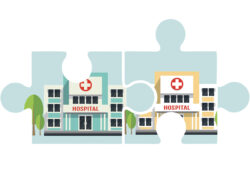Consistencies in EHR documentation help inform patient care
A 2018 study1 revealed that nurses spend 25% of their time on documentation—inclusive of entering patient data into an electronic health record (EHR) or paper chart and then reviewing the information.
Within an acute care environment, these essential functions typically take place at the nurses’ station, in the hallway or in patient rooms. While many view documentation as a burden, the rich data that is collected and entered into an EHR is also seen as a potential source of scalable knowledge to inform care delivery and aid in the evaluation of patient outcomes. When standardized across an integrated delivery network (IDN), this data becomes invaluable.

This reality was the motivation of visionaries who set out to develop a national collaborative process to create a minimum set of standard, usable and reusable data from patients’ admission history as captured by nurses in an EHR. Their work found that reducing documentation to only that which is essential to care, entered in a standardized format, reduces the “burden” of documentation.
History of collaboration
2013: A national collaborative effort began in 2013 at the University of Minnesota (U of M) School of Nursing. Workgroups formed with deliverables, and the collaboration evolved into an annual event—the Nursing Knowledge Big Data Science (NKBDS) Conference. Over the following five years, the workgroups met virtually on a regular basis, and annually in June at U of M to address care coordination, clinical data analytics, context of care, education, encoding and modeling, e-repository, mobile health, nursing value, policy, social determinants of health and transforming documentation.
2018: At the 2018 NKBDS meeting, a joint task force was formed with the focus of usable and reusable data as its charge. The resulting group was the Admission History Task Force, composed of practicing clinicians and experts from academia and the healthcare industry who were members of five NKBDS workgroups: Transforming Documentation, Care Coordination, Social Determinants of Health, Clinical Data Analytics and Encoding/Modeling. The task force was approved to move forward with the goal of creating a repeatable process that could be used for other elements of documentation, for other patient populations in any care setting. An adult patient in the acute care environment was selected as the component of nursing documentation to optimize.
2019: While the topic and related ideas had been in discussion since 2013, the Admission History Task Force members agreed to an aggressive timeline for content development—July 2019—just nine months from its inception. For purposes of the project, participants agreed to assume the patients’ acute care admission history as being from the point of the initial patient/family interview (providing background for the current episode of care) and transition to the next phase of care. The task force then defined the categories that were the responsibility of nursing and transitioned the document to a separate task force to map related content to the appropriate terminology.

Nursing process and documentation expectations, as well as the experience of organizations that had redesigned admission histories within the last five years, were instrumental in outlining guiding principles for the work of this project. According to article co-author and Admission History Task Force member, Jane Englebright, Ph.D., RN, CENP, FAAN, SVP and Chief Nurse Executive at HCA Healthcare, “It was critical that we worked toward generating important data in the context of documentation burden mitigation, but ultimately toward the international desire to share and compare nursing data in patient outcome evaluation.”
2021: The work of the task force was highlighted in an article, “A Framework for National Collaboration to Reduce Documentation Burden and Design for Usable and Reusable Data,” published recently in The Journal of Nursing Administration (JONA).2 The article details the collaborative journey of the visionary nurse leaders and experts who generated national consensus recommendations on documentation elements related to admission history.
Remember meaningful use?
The JONA article also refers to the history of meaningful use guidelines that were ushered in as part of 2009 legislation, when the government provided billions of reimbursement dollars for healthcare providers to expand the use of EHRs. While the expansion was rapid and created a blueprint focused on elements of clinical care delivery, article authors suggest it lacked basic guidelines for design, usability and data reuse, enabling the fragmented environment. Users soon realized that maintaining and expanding EHRs was a huge burden to bear.
Also contributing to issues of meaningful use were data entered in the wrong place, wording inconsistencies and disparate EHRs across a health system’s facilities, often due to merger and acquisition activity. Other inconsistencies are often found as well, running contrary to the suggested guiding principles for content and formatting as outlined in the guiding principles sidebar.
Because the functionality of each EHR varies, article authors advise that “other groups working on similar problems focus on the essence of the content for maximum generalizability.” They add, “However, it should be noted that the workflow within the content may come across differently, based on EHR functionality. Additional edits may be needed to match workflow in individual organizations.”

Article co-author and Admission History Task Force member Sarah Michel, MBA, BSN, RN, NE-BC, Director, Research & Clinical Engagement, HealthTrust Clinical Services, adds, “This work proves that collaboration at a national level to reduce documentation burden and improve data usability is possible and highly productive. It has resulted in the creation of a framework, so the process can be replicated across other areas of a patient’s record within an EHR.”
In practice
Tackling documentation burden starts with getting organized and determining participants for the work effort. Five critical teams with expertise from these stakeholders is key:
- CNO leadership as an executive champion
- A caregiver who performs admission history interviews
- Nurse informaticists and information technologists who understand the EHR system
- Risk management, regulatory compliance, case management, nutrition services &/or rehabilitation services
- Project management
The Q4 edition of The Source will provide more information and tools for providers interested in starting their journey in tackling documentation burden.
Sources:
- ncbi.nlm.nih.gov/pmc/articles/PMC6371290/#:~:text=In%20our%20study%2C%20we%20found,and%20paper%20charting%20and%20review
- pubmed.ncbi.nlm.nih.gov/33570374
Read an abstract or purchase the full JONA article.
Share Email EHR, Nursing, Performance Improvement, Q3 2021




